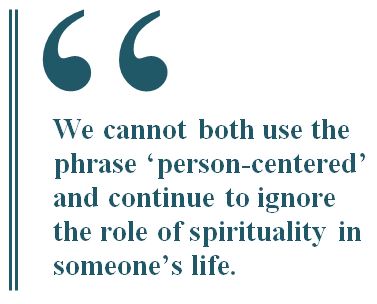by David Morstad
For years – probably for as long as US federal funding has been in place – there has been an uncomfortable relationship between professional support providers and the issue of religion and spirituality in the lives of the people they support. In a nutshell, there has often been a reluctance on the part of support provider organizations when it comes to actively supporting the spiritual practices of the individuals whom they support for fear that this somehow violates a delicate “church and state” issue. It is a statement that seems logical enough on the surface, yet there is little to support it.
It’s time to call the church/state issue in this case what it is: a myth, pure and simple. Not only does the first amendment guarantee the right of free expression of religion, but more recent legislation amplifies it in the case of people with disabilities. The Religious Land Use and Institutionalized Persons Act,passed in 2000, protects religious expression for individuals living in”institutions including prisons, jails, pretrial detention facilities, juvenile facilities, and facilities housing persons with disabilities when these facilities are controlled by or provide services on behalf of State or local governments.” That last phrase includes Medicaid waiver services. In addition, the Freedom of Access to Clinic Entrances and Places of Religious Worship Act passed in 1994 prohibits any barrier that “interferes with a person seeking to the First Amendment right of religious freedom at a place of religious worship.”
 The protections of an individual’s religious expression abound, and the news is about to get even better. Waiting in the wings are a new set of federal regulations affecting Home and Community-Based Services (HCBS), e.g., group homes, supported living services, etc. While these regulations do not specifically call out religious and other spiritual expression, they do something even better – they place control of these matters into the hands of the person being supported. The regulations are explicit: “The person-centered planning process is driven by the individual.”
The protections of an individual’s religious expression abound, and the news is about to get even better. Waiting in the wings are a new set of federal regulations affecting Home and Community-Based Services (HCBS), e.g., group homes, supported living services, etc. While these regulations do not specifically call out religious and other spiritual expression, they do something even better – they place control of these matters into the hands of the person being supported. The regulations are explicit: “The person-centered planning process is driven by the individual.”
Consider some of the other content of the regulations through the eyes of religious/spiritual expression. The plan and documentation:
- “reflect cultural considerations.” ‘Cultural’ in this case is not limited to ethnicity, but includes family and community.
- “are conducted to reflect what is important to the individual to ensure delivery of services in a manner reflecting personal preferences.”
- Include individually identified goals and preferences related to relationships, community participation…
- Includes the input and activity of “unpaid supports provided voluntarily in lieu of waiver or state plan HCBS”, understanding that the friends and relationships chosen by the individual are as legitimate and important (often more so) as paid activities and caregivers.
The regulations took effect in 2014, and states have until 2019 to develop plans of compliance and hold provider organizations accountable. The federal language and concepts have caught up to a long-standing philosophical position among many in the field: “The requirements maximize opportunities for individuals to have access to the benefits of community living and the opportunity to receive services in the most integrated setting.” It is bold stuff and it suggests to me that, as professionals, we cannot both use the phrase “person-centered”, and ignore the role of spirituality in someone’s life.
In recent years, we have come to appreciate the practical impact of faith communities as natural support networks. This nudge by a new set of regulations may point toward a renewed understanding of the deeper, choice-honoring nature of planning and supports.

I so appreciate your well written articles. I use them and quote them. You will chuckle to know that the western division Ministry consultants discussed this one recently! I am wondering if you have done or know of more work on spiritual assessments or faith support plans. We had several discussions about it and I believe you and Laura Lee did an AAIDD presentation? Hope you are well.
LikeLike
Thanks for stopping by, Mona. I’ve tried to write more about the specifics of addressing spirituality in the support planning process, but the end result always seems a bit misguided. Perhaps it’s because I am fundamentally averse to faith being one more thing that is “assessed”. In your life and mine it’s wound into everything – vocation, relationships, service, etc. Faith isn’t another patch on the quilt, it’s the thread that holds things in place. Making spirituality work in the world of support services, in my humble opinion, is less about assessment and more about dialogue. Lots and lots of dialogue.
LikeLike
I disagree. What you object to is semantics. What you suggest is impractical in the world of support services. How many providers are you aware of who even care about spiritual supports? Few, if any, that I have found. Some instrument to log or delineate ideas and choice is a helpful place to start the “dialogue” you seek. Mona
LikeLike